
Transportation in Cuba
Encyclopedia
Transportation in Cuba
is composed of a system of railways, roads, airports, waterways, ports and harbours:
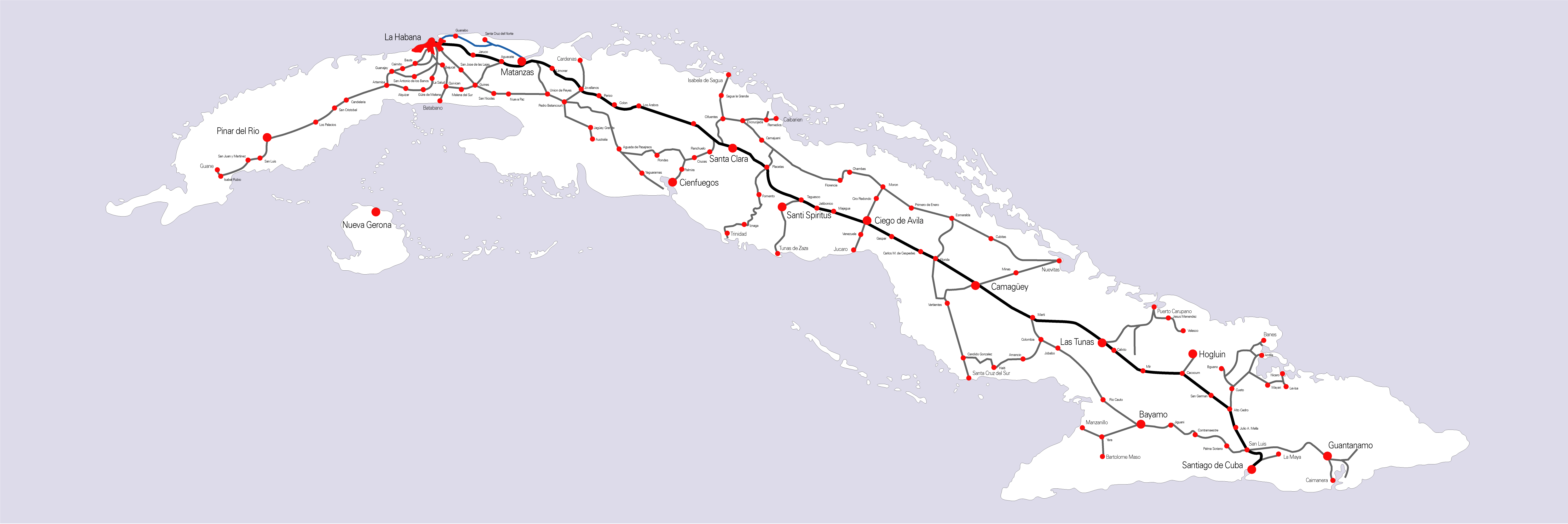
Cuba built the first railway system in the Spanish empire, before the 1848 start in the Iberian peninsula
. While the rail infrastructure dates from colonial and early republican times, passenger service along the principal Havana to Santiago corridor is increasingly reliable and popular with tourists who can purchase tickets in Cuban convertible peso
s. As with most public transport in Cuba, the vehicles used are second hand, and the flagship Tren Francés ("French train") between Havana
and Santiago de Cuba
is operated by coaches originally used in Europe between Paris and Amsterdam on the ex-TEE
express. The train is formed by 12 coaches and a Chinese-built locomotive
.
With the order of 12 new Chinese locomotives, built specially for Cuban Railways at China Northern Locomotives and Rolling Stock Works, services have been improving in reliability. Those benefiting the most are long distance freight services with the French train Havana-Santiago being the only passenger train using one of the new Chinese locomotives regularly. Various orders are in place for 100 locomotives from China and various freight wagons and passenger coaches.
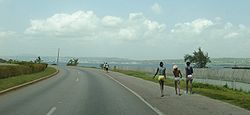 The total length of Cuba's highways is 60,858 km, including
The total length of Cuba's highways is 60,858 km, including
Expressways (autopista
s) include
Older roads include the Carretera Central, and the Via Blanca from Havana to Matanzas.
On 27 June 2007 it was reported that Cuba will start assembling the 200 first Yutong buses for inter-municipal transportation starting the second half of 2007.
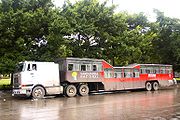
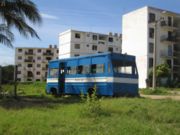
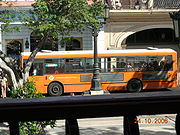 In Havana urban transportation is provided by a colourful selection of buses imported from the Soviet Union or Canada. Many of these vehicles are second hand (such as the 1500 decommissioned Dutch buses, which the Netherlands donated to Cuba in the mid 1990s) and despite the United States trade embargo, American-style yellow school buses (imported second-hand from Canada) are increasingly common sights. On seven key lines in and out of the city, service is provided by camellos ("camels" or "dromedaries", after their "humps"), trailer bus
In Havana urban transportation is provided by a colourful selection of buses imported from the Soviet Union or Canada. Many of these vehicles are second hand (such as the 1500 decommissioned Dutch buses, which the Netherlands donated to Cuba in the mid 1990s) and despite the United States trade embargo, American-style yellow school buses (imported second-hand from Canada) are increasingly common sights. On seven key lines in and out of the city, service is provided by camellos ("camels" or "dromedaries", after their "humps"), trailer bus
es that haul as many as two hundred passengers in a passenger carrying trailer. The camellos will be phased out in April 2008 with Chinese Zhengzhou Yutong Bus
es.
After the upgrading of Seville
's public bus fleet to CNG-powered
and new vehicles, many of the decommissioned ones
were donated to the city of Havana. These bright orange buses still display the name of Transportes Urbanos de Sevilla, S.A.M., their former owner, and Seville's coat of arms as a sign of gratitude.
On 18 July 2007 it was reported that Cuba will receive 100 urban buses from Belarus before years end, destined for use in Havana.
Cuban State Council Vice President Carlos Lage declared in 2007 that Cuba would receive 1,142 more Chinese buses for urban transport before years end
As well, the Castro government found an alternate source for vehicles in its new patron, the Soviet Union, which supplied the island with Volgas, Moskvich 1500s, Ladas and other Eastern Bloc cars, mainly for state use. The Soviet Union also sent heavy trucks such as the ubiquitous ZIL and the rugged KrAZ. Cars also trickled in from Europe and, in later years, Asia. Since 2009, Cuba has imported sedans from Chinese automaker Geely to serve as police cars, taxis and rental vehicles.
While many older Soviet and European cars remain in service in Cuba, they are largely eclipsed by the island's great 1950s Cadillacs, Packards, De Sotos and similar products from one of the most ornate styling periods in U.S. auto history. Their pastel colours, tall fins and extensive chrome make them a favouriste subject for tourist photographs.
As many as 60,000 American vehicles are in use on the island, nearly all in private hands. Pre-1960 vehicles remain the property of their original owners and descendents, and can be sold to other Cubans providing the proper traspaso certificate is in place. Such transactions can be difficult, but in 2010, reforms approved by a Communist Party congress were expected to legalize the sale between Cuban citizens of all cars, as well as real estate.
Of Cuba's vintage American cars, any have been modified with newer engines, disc brakes and other parts, often scavenged from Soviet cars, and most bear the marks of decades of use. A Others, however, have been lovingly preserved in their original condition, and would be coveted by collectors in other countries. Apart from a brief period in the 1990s, however, the Castro government has forbidden the sale of Cuban vehicles to foreigners.
" in 1991 (energy shortages caused by the loss of the Soviet Union as a trading partner), hitchhiking and carpooling have become important parts of Cuba's transportation system and society in general. In 1999, an article in Time
magazine claimed "In Cuba[...] hitchhiking is custom. Hitchhiking is essential. Hitchhiking is what makes Cuba move."
), the two other major Cuban airlines are Aero Caribbean and Aerogaviota, both of whom operate modern European and Russian aircraft. One other airline is Aerotaxi.
Cuba
The Republic of Cuba is an island nation in the Caribbean. The nation of Cuba consists of the main island of Cuba, the Isla de la Juventud, and several archipelagos. Havana is the largest city in Cuba and the country's capital. Santiago de Cuba is the second largest city...
is composed of a system of railways, roads, airports, waterways, ports and harbours:
Railways

- total: 11,968 km (4,226 km + 7,742 km)
- standard gaugeStandard gaugeThe standard gauge is a widely-used track gauge . Approximately 60% of the world's existing railway lines are built to this gauge...
: 4,226 km gauge (140 km electrified) - note: an additional 7,742 km of track is used by sugar plantations; about 65% of this track is standard gauge; the rest is narrow gauge (2003)
Cuba built the first railway system in the Spanish empire, before the 1848 start in the Iberian peninsula
History of rail transport in Spain
Rail transport in Spain operates on four rail gauges and services are operated by a variety of private and public operators. The total route length in 2008 was 15,288 km :...
. While the rail infrastructure dates from colonial and early republican times, passenger service along the principal Havana to Santiago corridor is increasingly reliable and popular with tourists who can purchase tickets in Cuban convertible peso
Cuban convertible peso
The convertible peso , is one of two official currencies in Cuba, the other being the peso. It has been in limited use since 1994, when it was treated as equivalent to the U.S. dollar: its value was officially US$1.00. On November 8, 2004, the U.S...
s. As with most public transport in Cuba, the vehicles used are second hand, and the flagship Tren Francés ("French train") between Havana
Havana
Havana is the capital city, province, major port, and leading commercial centre of Cuba. The city proper has a population of 2.1 million inhabitants, and it spans a total of — making it the largest city in the Caribbean region, and the most populous...
and Santiago de Cuba
Santiago de Cuba
Santiago de Cuba is the second largest city of Cuba and capital city of Santiago de Cuba Province in the south-eastern area of the island, some south-east of the Cuban capital of Havana....
is operated by coaches originally used in Europe between Paris and Amsterdam on the ex-TEE
Trans Europ Express
The Trans Europ Express, or Trans-Europe Express, is a former international railway service in Europe. At its maximum extent, in 1974, the network comprised 45 trains, connecting 130 different cities.-Origin:...
express. The train is formed by 12 coaches and a Chinese-built locomotive
Locomotive
A locomotive is a railway vehicle that provides the motive power for a train. The word originates from the Latin loco – "from a place", ablative of locus, "place" + Medieval Latin motivus, "causing motion", and is a shortened form of the term locomotive engine, first used in the early 19th...
.
With the order of 12 new Chinese locomotives, built specially for Cuban Railways at China Northern Locomotives and Rolling Stock Works, services have been improving in reliability. Those benefiting the most are long distance freight services with the French train Havana-Santiago being the only passenger train using one of the new Chinese locomotives regularly. Various orders are in place for 100 locomotives from China and various freight wagons and passenger coaches.
Roads

- paved: 29,820 km (including 638 km of expressway)
- unpaved: 31,038 km (1999 est.)
Expressways (autopista
Autopista
Autopista refers to a controlled-access highway in various Spanish-speaking countries*Autopistas and autovías of Spain*Autopistas of Mexico*Autopistas of Puerto Rico*Autopistas of Chile...
s) include
- the Autopista Nacional (A1) from Havana to Santa ClaraSanta Clara, CubaSanta Clara is the capital city of the Cuban province of Villa Clara. It is located in the most central region of the province and almost in the most central region of the country.- History :Santa Clara was founded by 175 people on July 15th, 1689...
and Sancti Spiritus, with additional short sections near SantiagoSantiago de CubaSantiago de Cuba is the second largest city of Cuba and capital city of Santiago de Cuba Province in the south-eastern area of the island, some south-east of the Cuban capital of Havana....
and GuantanamoGuantánamoGuantánamo is a municipality and city in southeast Cuba and capital of Guantánamo Province.Guantánamo is served by the Caimanera port and the site of a famous U.S. Naval base. The area produces sugarcane and cotton wool... - the Autopista Este-Oeste (A4) from Havana to Pinar del RíoPinar del RíoPinar del Río is a city in Cuba. It is the capital of Pinar del Río Province.Inhabitants of the area are called Pinareños.Neighborhoods in the city include La Conchita, La Coloma, Briones Montoto and Las Ovas.-History:...
- the Autopista del Mediodia from Havana to San Antonio de los BañosSan Antonio de los BañosSan Antonio de los Baños is a municipality and city in the Artemisa Province of Cuba.It is located 26 km from the city of Havana, and the Ariguanabo River runs through it. The city was founded in 1802....
- an autopista from Havana to Melena del Sur
- an autopista from Havana to MarielMarielMariel may refer to:* Mariel , given name.* Mariel, Cuba, a municipality and city in Cuba.* The Mariel boatlift, a 1980 exodus of Cubans to the United States.* Mariel Hemingway, actress and granddaughter of Ernest Hemingway....
- the Havana ring road , which starts at a tunnel under the entrance to Havana HarborHavana HarborHavana Harbor is the port of Havana, the capital of Cuba, and it is the main port in Cuba . Most vessels coming to the island make port in Havana...
- the section of the Via BlancaVia Blanca (Cuba)Via Blanca is a highway in northern Cuba, connecting the capital city of Havana and the city of Matanzas. A second section extends eastwards from Matanzas to the tourist town of Varadero.It is mostly a four lane highway, with some divided sections...
from MatanzasMatanzasMatanzas is the capital of the Cuban province of Matanzas. It is famed for its poets, culture, and Afro-Cuban folklore.It is located on the northern shore of the island of Cuba, on the Bay of Matanzas , east of the capital Havana and west of the resort town of Varadero.Matanzas is called the...
to VaraderoVaraderoVaradero is a resort town in the province of Matanzas, Cuba, and one of the largest resort areas in the Caribbean. Varadero is also called Playa Azul, which means "blue beach" in Spanish.-Geography:...
(toll road)
Older roads include the Carretera Central, and the Via Blanca from Havana to Matanzas.
Long-distance and inter-municipality buses in Cuba
There are two national bus companies in Cuba. Viazul operate a fleet of modern and comfortable coaches on longer distance routes designed principally for tourists. Slower and less reliable services are provided by Astro Bus, generally with much older vehicles, many imported from the Soviet Union. These services are significantly cheaper than Viazul, and are therefore increasingly popular with budget conscious tourists and visitors to Cuba. However, ASTRO (Asociacion de Transporte por Omnibus) has recently purchased from the Chinese manufacturer Yutong Bus a fleet of nearly 1000 air-conditioned units. They are being used on most of the long distance routes nationwide and some services have been increased. However, the ticket price was also raised recently, making it less affordable for the regular Cuban that chooses ASTRO to travel. Routes that have benefited most so far are those from Havana to each of the 13 provincial capitals of the country.On 27 June 2007 it was reported that Cuba will start assembling the 200 first Yutong buses for inter-municipal transportation starting the second half of 2007.
Urban buses



Trailer bus
A trailer bus or articulated trailer bus is a bus formed out of a bus bodied semi-trailer pulled by a conventional tractor unit in the same way as a conventional articulated semi-trailer truck....
es that haul as many as two hundred passengers in a passenger carrying trailer. The camellos will be phased out in April 2008 with Chinese Zhengzhou Yutong Bus
Zhengzhou Yutong Bus
Zhengzhou Yutong Group Co., Ltd. or commonly known as the , is a conglomerate based in Zhengzhou, Henan province, China focused on bus manufacturing as the core business, engineering machinery and real estate as the strategic business and at the same time giving attention to other investment...
es.
After the upgrading of Seville
Seville
Seville is the artistic, historic, cultural, and financial capital of southern Spain. It is the capital of the autonomous community of Andalusia and of the province of Seville. It is situated on the plain of the River Guadalquivir, with an average elevation of above sea level...
's public bus fleet to CNG-powered
Compressed natural gas
Compressed natural gas is a fossil fuel substitute for gasoline , diesel, or propane/LPG. Although its combustion does produce greenhouse gases, it is a more environmentally clean alternative to those fuels, and it is much safer than other fuels in the event of a spill...
and new vehicles, many of the decommissioned ones
Iveco
Iveco, an acronym for Industrial Vehicle Corporation, originally an alliance of European commercial vehicle manufacturers such as Fiat , Unic and Magirus. Iveco is now an Italian truck, bus, and diesel engine manufacturer, based in Turin...
were donated to the city of Havana. These bright orange buses still display the name of Transportes Urbanos de Sevilla, S.A.M., their former owner, and Seville's coat of arms as a sign of gratitude.
On 18 July 2007 it was reported that Cuba will receive 100 urban buses from Belarus before years end, destined for use in Havana.
Cuban State Council Vice President Carlos Lage declared in 2007 that Cuba would receive 1,142 more Chinese buses for urban transport before years end
Automobiles
Cuba is famous for its old cars and trucks, which can be seen in daily use throughout the country. For the first part of the 20th century, most new vehicles came to Cuba from the United States. The flow stopped in late 1959 when economic reforms by the then-new government of Fidel Castro prevented Cubans from buying cars on credit. A subsequent U.S. trade embargo, instituted in October 1960 in response to Cuba's seizure of U.S.-owned properties, not only ensured that new vehicle exports would remain halted, but also denied Cuban motorists a direct source of replacement parts. As a result, Cubans became expert at adapting or fabricating parts to keep on the road cars that in other countries would long since have been recycled.As well, the Castro government found an alternate source for vehicles in its new patron, the Soviet Union, which supplied the island with Volgas, Moskvich 1500s, Ladas and other Eastern Bloc cars, mainly for state use. The Soviet Union also sent heavy trucks such as the ubiquitous ZIL and the rugged KrAZ. Cars also trickled in from Europe and, in later years, Asia. Since 2009, Cuba has imported sedans from Chinese automaker Geely to serve as police cars, taxis and rental vehicles.
While many older Soviet and European cars remain in service in Cuba, they are largely eclipsed by the island's great 1950s Cadillacs, Packards, De Sotos and similar products from one of the most ornate styling periods in U.S. auto history. Their pastel colours, tall fins and extensive chrome make them a favouriste subject for tourist photographs.
As many as 60,000 American vehicles are in use on the island, nearly all in private hands. Pre-1960 vehicles remain the property of their original owners and descendents, and can be sold to other Cubans providing the proper traspaso certificate is in place. Such transactions can be difficult, but in 2010, reforms approved by a Communist Party congress were expected to legalize the sale between Cuban citizens of all cars, as well as real estate.
Of Cuba's vintage American cars, any have been modified with newer engines, disc brakes and other parts, often scavenged from Soviet cars, and most bear the marks of decades of use. A Others, however, have been lovingly preserved in their original condition, and would be coveted by collectors in other countries. Apart from a brief period in the 1990s, however, the Castro government has forbidden the sale of Cuban vehicles to foreigners.
Hitchhiking and carpooling
Since the start of the "Special PeriodSpecial Period
The Special Period in Time of Peace in Cuba was an extended period of economic crisis that began in 1991 after the dissolution of the Soviet Union and, by extension, the Comecon. The economic depression of the Special Period was at its most severe in the early-to-mid 1990s before slightly declining...
" in 1991 (energy shortages caused by the loss of the Soviet Union as a trading partner), hitchhiking and carpooling have become important parts of Cuba's transportation system and society in general. In 1999, an article in Time
Time (magazine)
Time is an American news magazine. A European edition is published from London. Time Europe covers the Middle East, Africa and, since 2003, Latin America. An Asian edition is based in Hong Kong...
magazine claimed "In Cuba[...] hitchhiking is custom. Hitchhiking is essential. Hitchhiking is what makes Cuba move."
Ports and harbors
- CienfuegosCienfuegosCienfuegos is a city on the southern coast of Cuba, capital of Cienfuegos Province. It is located about from Havana, and has a population of 150,000. The city is dubbed La Perla del Sur...
- HavanaHavanaHavana is the capital city, province, major port, and leading commercial centre of Cuba. The city proper has a population of 2.1 million inhabitants, and it spans a total of — making it the largest city in the Caribbean region, and the most populous...
- ManzanilloManzanillo, CubaManzanillo is a municipality and city in the Granma Province of Cuba.It is a port city in the Granma Province in eastern Cuba on the Gulf of Guacanayabo, near the delta of the Cauto River...
- MarielMarielMariel may refer to:* Mariel , given name.* Mariel, Cuba, a municipality and city in Cuba.* The Mariel boatlift, a 1980 exodus of Cubans to the United States.* Mariel Hemingway, actress and granddaughter of Ernest Hemingway....
- MatanzasMatanzasMatanzas is the capital of the Cuban province of Matanzas. It is famed for its poets, culture, and Afro-Cuban folklore.It is located on the northern shore of the island of Cuba, on the Bay of Matanzas , east of the capital Havana and west of the resort town of Varadero.Matanzas is called the...
- NuevitasNuevitasNuevitas is a municipality and port city in the Camagüey Province of Cuba. The large bay was sighted by Christopher Columbus in 1492. Founded in 1775, the city was moved to its present site in 1828.-Geography:...
- Santiago de CubaSantiago de CubaSantiago de Cuba is the second largest city of Cuba and capital city of Santiago de Cuba Province in the south-eastern area of the island, some south-east of the Cuban capital of Havana....
Merchant marine
- Total: 13 ships (1,000 GRTGross Register TonnageGross register tonnage a ship's total internal volume expressed in "register tons", one of which equals to a volume of . It is calculated from the total permanently enclosed capacity of the vessel. The ship's net register tonnage is obtained by reducing the volume of non-revenue-earning spaces i.e...
or over) totaling 54,818 GRT/
Ships by type
- Bulk carrierBulk carrierA bulk carrier, bulk freighter, or bulker is a merchant ship specially designed to transport unpackaged bulk cargo, such as grains, coal, ore, and cement in its cargo holds. Since the first specialized bulk carrier was built in 1852, economic forces have fueled the development of these ships,...
s (3) - Cargo shipCargo shipA cargo ship or freighter is any sort of ship or vessel that carries cargo, goods, and materials from one port to another. Thousands of cargo carriers ply the world's seas and oceans each year; they handle the bulk of international trade...
s (4) - Gas-carrying tankersLNG carrierAn LNG carrier is a tank ship designed for transporting liquefied natural gas . As the LNG market grows rapidly, the fleet of LNG carriers continues to experience tremendous growth.-History:...
(1) - Petroleum tanker (3)
- Refrigerated cargo shipsReefer (ship)A refrigerator ship is a type of ship typically used to transport perishable commodities which require temperature-controlled transportation, mostly fruits, meat, fish, vegetables, dairy products and other foodstuffs....
(2)
- Registered in other countries: 35 (2003 est.)
Airlines
Besides the state owned airline Cubana (Cubana de AviaciónCubana de Aviación
Cubana de Aviación S.A., commonly known as Cubana, is Cuba's largest airline and flag carrier. The airline was founded on 8 October 1929, and has its corporate headquarters in Havana. Its main base is at José Martí International Airport...
), the two other major Cuban airlines are Aero Caribbean and Aerogaviota, both of whom operate modern European and Russian aircraft. One other airline is Aerotaxi.
Airports with paved runways
- total: 70
- over 3,047 m: 7
- 2,438 to 3,047 m: 9
- 1,524 to 2,437 m: 20
- 914 to 1,523 m: 6
- under 914 m: 37 (2003 est.)
Airports with unpaved runways
- total: 95
- 914 to 1,523 m: 29
- under 914 m: 62 (2003 est.)

